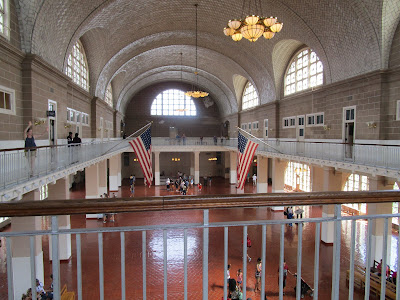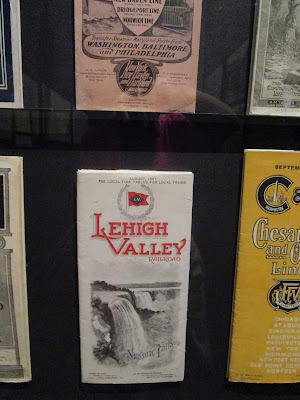 |
| Me standing on the pedestal of the Statue Of Liberty on a hot humid day. Really increased my tan. |
Last Saturday I arrived in New York City for the first time. On Monday I ferried over to Liberty Island to view the Statue of Liberty, and then on to Ellis Island. This was a highlight of my life. I had a euphoric feeling on the cruise out. Seeing the Statue of Liberty as my Great-Grandparents would have seen it was an extremely moving experience. I'll outline some of what I learned about the experience of immigrants processing through Ellis Island. Sadly, I don't have any stories regarding my ancestors trips through Ellis Island.
First of all here are a few pics I took going out:
Liberty Island is beautiful! Great views of Manhattan too.
The original wooden building on Ellis Island burned down in 1897. When Christian and Franz Koppel arrived in 1895 they were processed there. When Maria and Franz came over in 1898 they actually processed at the temporary barge building in Battery Park, as was Christian in 1899.
In February 1900 Maria Kurta-Kappel's father, Johann Kurta, visited the family. The new brick building was not open yet, so he also was processed at Battery Park. It was not until December of that year that the new building was completed for processing. Apparently Johann Kurta and his daughter Maria (my great-grandmother) returned to Inzenhof together. She returned to her home, and husband, in Pennsylvania in 1901. She was not yet a citizen, and traveled steerage. She would have come again through Ellis Island, this time through the current building .
When Maria Kurta-Kappel's husband relocated to Pittsburgh she again returned to Inzenhof. In 1905 she still isn't a citizen and again travels steerage, again she would process through Ellis island, and at that point joins her husband in Pittsburgh. This time she travels with her young daughter also named Maria.
 |
| The strings of numbers I highlighted represent later document checks, such as when Maria became a citizen in 1939. Lookups were also performed for two children in the 1940's. |
I'm not sure whether my Irish Grandmother Helen Mullen-Mason came through Ellis Island? I have not been able to find a passenger list for her anywhere. It's likely she did come through there. The 1897 fire destroyed many passenger lists, and the temporary location created problems with the records too. Her sister Bridget Mullen appears on a 1907 passenger list for the port of New York.
They would have disembarked from a ferry taking them to the island at the same place I disembarked.
The ship tickets were generally on large sheets of paper. I was thinking they are so much larger than the tickets printed at the airport, but if you print your ticket at home it is on an 8 1/2 by 11 inch piece of paper. Many of the ship tickets were much larger than 8 1/2 by 11 however. They were sometimes huge certificates. Not so easy to lose. The passengers had to pay for a round trip ticket in case they didn't pass the inspection at Ellis Island. Steerage tickets were inexpensive, the average cost of a ticket was $30.
Immigrants would walk into the processing building loaded down with their belongings. They would receive a numbered tag for processing.
 | ||
| Ship ticket. It's really large |
 |
| Registry Room were the procession was conducted. This room still contains some original benches. |
The physical inspection would begin at the upstairs landing. The medical inspectors were waiting at the top. They would take note of anyone who had difficulty climbing the stairs. A more extensive physical examination would take place including an exam for the eye disease trachoma. A button hook was used to lift the eyelids for this exam. I would hate that. Hate anyone touching my eyes. An excellent hospital was built on the island in 1902. If someone had a curable disease they were treated at this hospital, and often admitted to the country after recovery. Hundreds of babies were born on the island, and 3000 people died there.
 |
| Hospital equipment |
Uniformed inspectors would interview the immigrants regarding their plans, and means of support. Uniformed officials were intimidating to many immigrants who were escaping military service or had been subjected to government oppression in their homeland.
Most immigrants were admitted to the country. Those singled out for further questioning and, or, inspection would have an X mark or SI noted by the number on the passenger list. SI meant they were held for a special inquiry hearing. Other letter marks signified suspected illnesses, such as H for heart etc.. Most of these immigrants were eventually admitted.
| Whole group of people held. One had a special inquiry hearing as noted by SI |
At one point IQ tests began to be administered. These tests involved piecing together a puzzle. Most immigrants passed. They were given several opportunities to pass.
Translators at Ellis Island were often either immigrants, or from immigrant families. These translators sometimes assisted the immigrants by giving them the right answers to the inspection questions.
The inspectors kept office hours. If you arrived late in the day and couldn't complete inspection you would spend the night in dormitories located above the registry room.
Typical stay on Ellis Island was round 3 hours, although you could be there much longer depending on the number of immigrants, and your particular situation as far as detention. None of my family members were detained.
 |
| Men's dormitory bunks for overnight stays |
 |
| Men's bunks |
 |
| Only one toilet for many people |
 |
| Balcony with doors leading to dorms. Women's dorms right men left. |
 |
| Women's dorm room |
After completing processing you would be directed to the separation staircase, which contained 3 aisles. One aisle lead to the New York City ferry, another lead to the train station for those heading away from New York City. Those who were detained or marked B to be sent back were sent down the center aisle of this staircase. Many being sent back or detained didn't know the significance of the separate aisles. They were marked with chalked marks on their clothing. Some immigrants were wise to these marks. Those marked for detainment or return sometimes wiped the chalk mark off and joined the crowds leaving the island. Not sure how many managed to subvert the process and make it to freedom?
 |
| Three aisle separation staircase |
My ancestors didn't stay in New York and therefore headed for the train station in New Jersey by ferry. The station, built in 1889, still stands but is abandoned. About 10.5 million immigrants entered the country through this station. Interesting there is a street named Houston in New York. This caused confusion with some immigrants wanting to go to this street being sent instead to trains heading for Houston, Texas.
 |
| Railway station my ancestors would have left from in New Jersey |
 |
| Train time table Lehigh Valley |
 |
| Railroad table Chicago |
The Freedom Tower elevator had a great video presentation on the way to the top. If you stop this video around the year your ancestor came you can see the New York they saw when they arrived in America.


















1 comment:
Nice Blog ...
Join us for a day trip to Niagara Falls Day Tripfor an unforgettable, awesome-inspiring experience!This wonder of the world is the perfect destination for a day trip out of the city.Take this fantastic Niagara Falls day tour with an all-inclusive package
Post a Comment